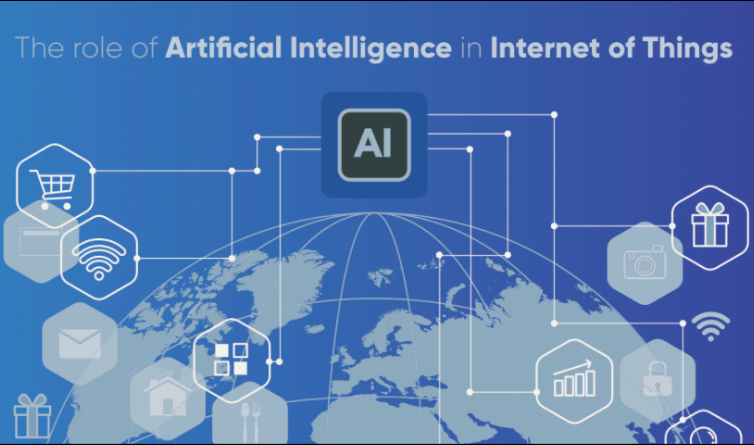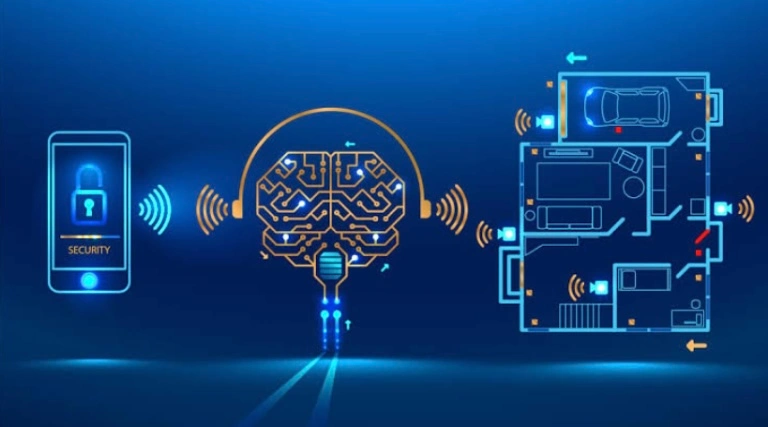The Internet of Things (IoT) relies heavily on artificial intelligence (AI) and machine learning (ML). They can be put to use in the process of sifting through the mountains of data produced by the Internet of Things gadgets to find the information that will prove most useful. Machine learning algorithms, for instance, can be educated to recognize trends and outliers in data, allowing firms to better assess situations and make strategic decisions.
Introduction
The way we connect with our surroundings, whether at home or at business, has been completely transformed by the Internet of Things (IoT). The Internet of Things (IoT) has made it possible for us to gather enormous volumes of data on a variety of factors, from humidity levels to energy use and equipment performance. Yet, humans find it challenging to interpret and gain value from this data because of the sheer volume and complexity of it.
Machine learning (ML) and artificial intelligence (AI) can help with this. Without human interference, robots can learn from data, spot patterns, and make judgments thanks to AI and ML algorithms. Organizations may get valuable insights & automate decision-making processes by using AI and ML to the data produced by IoT devices.
The purpose of AI & ML in IoT in this context is to make it possible for businesses to get value from the enormous volumes of data that IoT devices create. In this article, we will examine the many IoT applications of AI and ML, such as energy optimization, anomaly detection, and predictive maintenance, and how they may benefit businesses by enhancing operational effectiveness, cutting costs, and opening up new revenue streams.

What Is Artificial Intelligence?
Artificial intelligence (AI) is the capacity of computers or computer programs to carry out operations that ordinarily call for human intelligence, such as comprehending natural language, identifying objects, and making judgments. Artificial intelligence (AI) systems are made to mimic human cognitive processes like learning, reasoning, problem-solving, & decision-making.
Rule-based systems & machine learning-based systems are the two broad categories into which AI systems can be divided. Whereas machine learning-based systems learn from data & continuously improve their performance, rule-based systems rely on pre-defined rules to carry out tasks.
Artificial intelligence (AI) is increasingly present in daily life, from self-driving cars and face recognition software to virtual personal assistants like Siri or Alexa. Healthcare, banking, and retail are just a few of the sectors that have been transformed by AI, which has allowed businesses to streamline operations, increase productivity, and base smarter decisions. Yet, the advancement of AI also brings up significant ethical and societal issues, such as the effect on employment, privacy, and prejudice in judgement.
As AI develops, it is critical to take into account both its advantages and disadvantages, as well as any potential threats, and to make sure that both its development and application are constrained by moral standards and a commitment to human welfare.
If you are interested in the Internet of Things (IoT), you can use IoT Training and join the course and improve your skills in this field.
What is Machine Learning in IOT?
The term “machine learning” (ML) in the context of the Internet of Things (IoT) refers to the use of algorithms & statistical models to let intelligent IoT devices learn from the data they gather without having to be explicitly programmed to do so.
Machine learning algorithms can be applied to the Internet of Things to evaluate massive volumes of data produced by sensors, connected devices, as well as other sources, and afterwards forecast the future or take actions based on that analysis. For instance, a device connected to the internet of things (IoT) that tracks a room’s temperature could use machine learning to identify trends in temperature changes over time and then automatically alter the temperature depending on those trends.
Predictive maintenance, anomaly detection, and energy usage optimization are some typical IoT uses of machine learning. A more intelligent, effective, and responsive Internet of Things ecosystem can result from the use of machine learning by IoT devices.
The Role of Artificial Intelligence and Machine Learning in IoT

Predictive maintenance, anomaly detection, & energy efficiency are the three key areas in which artificial intelligence and machine learning play a significant role in the Internet of Things.
Predictive Maintenance
By collecting data from sensors on machinery and equipment, predictive maintenance may foresee when maintenance is required. AI and ML algorithms can predict when a machine is likely to malfunction and schedule maintenance in advance by looking for trends in the data. Using this strategy, equipment downtime may be decreased, equipment reliability can be increased, and unplanned maintenance expenditures can be avoided.
Anomaly Detection
Monitoring the data produced by IoT devices & spotting patterns that differ from expected behaviour is the process of anomaly detection. Organizations can utilize AI and ML algorithms to spot abnormalities in real-time and take action before security attacks, equipment breakdowns, and other problems result in major harm. This can help to increase safety and lower the possibility of expensive downtime.
Energy Optimization
In order to find patterns and create adjustments that lower energy consumption and save money, energy optimization entails evaluating data from sensors on lights, HVAC, and other systems. Based on variables like occupancy, weather, & building usage patterns, AI and ML algorithms can be utilized to optimize energy consumption. This could aid in lowering energy expenditures, enhancing sustainability, and increasing the general effectiveness of structures and other systems.
In addition to these particular uses, AI and ML can be utilized to enhance IoT systems’ overall data management. AI and ML algorithms, for instance, can be used to recognize and categorize data from different sensors, obviating the need for manual data entry as well as enhancing the precision and comprehensiveness of data sets. Data from many sources can be analyzed using AI and ML to find correlations and insights that would not be obvious from single data sets alone.
In general, the purpose of artificial intelligence and machine learning in IoT is to help businesses derive value from the enormous amounts of data that IoT devices generate. AI and ML may assist firms in enhancing operational efficiency, cutting expenses, and opening up new business prospects by automating decision-making procedures, forecasting failures, detecting abnormalities, and optimizing energy usage.
It is crucial to make sure that AI development and application are constrained by moral standards and a commitment to human welfare. However, the development of AI also raises significant ethical and societal issues.
Difference between artificial intelligence and machine learning
There are some distinctions between the fields of artificial intelligence (AI) & machine learning (ML), despite the fact that they are closely linked and frequently used interchangeably. The development of intelligent computers that can carry out tasks that typically require human intelligence, like reasoning, learning, perception, and decision-making, is the focus of the broad field of artificial intelligence (AI).
It entails developing intelligent systems capable of observing their surroundings, making judgments about them, and acting in a way that increases their chances of success. A subset of artificial intelligence called “machine learning” deals with creating algorithms and statistical models that let computers learn from data without having to be explicitly programmed. In other words, it is a method that enables robots to gain knowledge from experience and develop over time.
Here are some key differences between AI and ML:
- Scope: Natural language processing, robotics, computer vision, and expert systems are just a few of the subfields that fall under the umbrella of artificial intelligence (AI). A branch of AI called machine learning (ML) concentrates on creating algorithms that let computers learn from data.
- Approach: AI entails the creation of intelligent systems capable of carrying out activities that call for human-like intellect. Through the use of ML, computers may learn from data without having to be explicitly programmed.
- Dependence on data: AI programs can be made to function with or without data. Since machine learning includes learning from data, it is completely dependent on data to function.
- Implementation: Rule-based systems, expert systems, neural networks, and other methods can all be used to implement AI. Algorithms like supervised learning, unsupervised learning, or reinforcement learning are frequently used to implement ML.
- Goal: AI aims to build machines that are capable of carrying out activities that call for human-like intelligence. The development of algorithms that allow machines to learn from data and gradually improve their performance is the aim of machine learning (ML).
Conclusion
The Internet of Things (IoT) has the potential to transform how businesses function and interact with their surroundings through the combination of artificial intelligence (AI) & machine learning (ML). AI and ML may assist firms in enhancing operational efficiency, cutting expenses, and opening up new business prospects by automating decision-making processes, forecasting failures, detecting abnormalities, and optimizing energy usage.
Yet, the advancement of AI and ML also brings up significant moral and cultural issues, such as the effect on employment, privacy, and prejudice in judgment. It is critical that moral ideals and a dedication to human welfare serve as the foundation for the development and application of AI and ML in the IoT. To prevent the compromise of sensitive information, organizations must also take into account the significance of data privacy and security.



